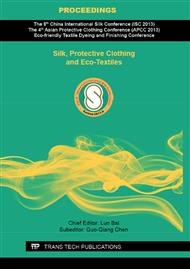p.408
p.412
p.416
p.424
p.428
p.432
p.439
p.443
p.447
In Situ Coloration of Silk with Coupling Reaction and the Spectrum Characteristics
Abstract:
High wet fastness dyeing is always the hot issue of silk industry. The plenty of tyrosine residue in silk protein may contribute an opportunity to solve this problem. In this paper, in situ coloration of silk is described using coupling reaction between diazonium compounds, made from different arylamine derivatives, and tyrosine residues in the silk fibroin. The spectra of coloured silk and the washing and rubbing fastness were measured. The results suggest that the use of coupling reactions could be developed into a dyeing method for silk. The wet fastness properties of such coloration are good because the chromophores are incorporated into the protein chains.
Info:
Periodical:
Pages:
428-431
Citation:
Online since:
September 2013
Authors:
Keywords:
Price:
Сopyright:
© 2013 Trans Tech Publications Ltd. All Rights Reserved
Share:
Citation:


